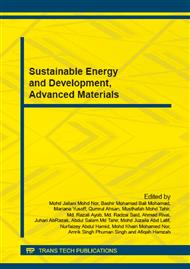p.32
p.38
p.44
p.49
p.53
p.59
p.64
p.70
p.76
Investigation of Photocatalytic Activity of TiO2-PANi Nanocomposites
Abstract:
In this paper the photocatalytic activity of TiO2-PANi nanocomposites prepared using two different In-situ polymerization methods have been investigated. The same pressure, temperature, precursors, mole ratio, and solvent have been employed for preparation of nanocomposites. The synthesized nanocomposites were characterized by FESEM, XRD and FTIR. Results revealed the successful preparation of TiO2- PANI nanocomposites. TiO2-PANi nanocomposite synthesized using method 2 showed very well dispersed TiO2 nanoparticles on the surface of PANi. There is no agglomeration of TiO2 nanoparticles in PANi matrix. The photocatalytic activities of nanocomposites were evaluated by using photo degradation of Methylene Blue (MB) in aqueous solution under UV irradiation. These nanocomposites exhibit much higher photocatalytic activity compared with TiO2.
Info:
Periodical:
Pages:
53-58
Citation:
Online since:
November 2014
Keywords:
Price:
Сopyright:
© 2015 Trans Tech Publications Ltd. All Rights Reserved
Share:
Citation:


